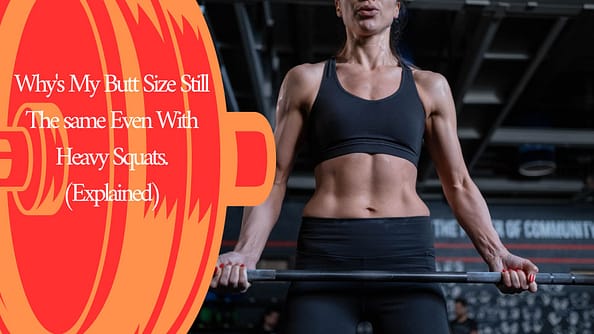Are you feeling frustrated with your lack of progress in building a bigger butt despite performing heavy squats? Read on to discover the truth behind why your butt size is not changing and what you can do to finally achieve the results you desire.
Heavy squats are an effective exercise to build lower body strength and muscle mass, including the glutes. However, if your butt size remains the same despite squatting heavy, it could be due to several reasons. For instance, you might not be using enough weight or volume to challenge your glute muscles, or your form might be incorrect, leading to less glute activation. Additionally, your genetics and body composition can also influence your butt size. Therefore, it’s essential to assess your training, form, and genetics to determine the best approach to achieve your desired butt size.
You might not be using enough weight or volume.
Your form might be incorrect, leading to less glute activation
Another possible reason for this could be that your form is incorrect, leading to less glute activation. You see, proper form is crucial when it comes to engaging the right muscles and maximizing your workout’s effectiveness.
If your form is off, you might be unintentionally shifting the workload to other muscles or not engaging your glutes enough, resulting in slower or no progress.
Don’t lose hope, though, there’s a fix for this! Make sure you’re using proper squatting technique, such as maintaining a neutral spine, driving through your heels, and pushing your hips back.
You can also consider incorporating glute-specific exercises or seeking guidance from a trainer to help you perfect your form and activate your glutes more effectively. Keep going, and don’t give up!

Your genetics
It’s very important to remember that genetics play a role in our body shape and size, including our glutes.
While squats are an effective exercise to build lower body strength and muscle mass, they might not be the only solution to achieving your desired butt size.
Our genetics determine our muscle fibers’ distribution, which can influence our muscle-building potential and size.
Therefore, don’t be too hard on yourself if your progress is slower than others or your butt size isn’t changing as much as you’d like. Keep in mind that everyone’s journey is different, and progress takes time, patience, and dedication.
Your Body composition can also influence your butt size
Assess your training, form, and genetics.
Remember that achieving your desired butt size is a complex process that involves various factors. Therefore, it’s IMPORTANT to assess your training, form, and genetics to determine the best approach for you.
Take some time to evaluate your squatting technique, weight and volume progression, and overall workout routine to ensure that you’re effectively stimulating your glutes.
Additionally, consider seeking guidance from a trainer or incorporating glute-specific exercises to activate your glutes more effectively.
Finally, remember that our genetics play a role in our body shape and size, including our glutes. Don’t compare yourself to others or be too hard on yourself if your progress is slower than expected.
Keep going, stay consistent, and trust the process. With dedication and patience, you can achieve your desired butt size.
Final Thoughts
In conclusion, building a bigger, firmer butt takes time, effort, and consistency. While heavy squats can be an effective exercise for targeting your glutes, it’s not the only factor that determines the size and shape of your butt.
If you’re not seeing results despite performing heavy squats, consider increasing your caloric intake, implementing progressive overload, correcting your form, and ensuring sufficient rest and recovery time. Additionally, be patient and kind to yourself. Building a bigger, firmer butt is a journey, and everyone’s body responds differently to exercise.
Remember that your worth and value are not determined by the size or shape of your butt. Embrace and celebrate your body, and focus on achieving your fitness goals for yourself, rather than external validation.
So, keep up the hard work, stay consistent, and don’t give up. With the right mindset, effort, and dedication, you’ll be able to achieve the results you desire and feel confident and proud in your body.
To keep your behind looking its best, you need to exercise regularly and maintain good eating habits. If you are experiencing the same problem, speak to your doctor about possible treatments.
Related Article:
Are Front Squats Better To Do Than Back Squats? (5 things to know- Explained)

Hey there, it’s Mike Rrsq, the Editor-in-Chief over at Jsquat.com, and I’m absolutely obsessed with all things squat fitness! I’ve been lucky enough to get some serious recognition for my work in this field. With a solid background in the fitness and wellness industry, I’ve been there right from the get-go, helping shape this website into what it is today.
You see, I’m not just the boss around here; I’m also a passionate contributor. I love sharing my insights through my articles, and trust me, they’re not your run-of-the-mill stuff. Each piece I write is a labor of love, filled with my expertise and real-world experience in the fitness universe. So, if you’re into fitness and looking for some inspiration, you’re in the right place!

